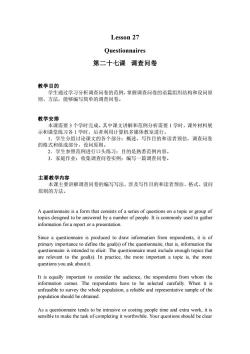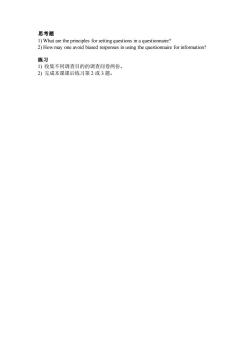对外经贸大学:《商务英语写作》课程教学资源(授课教案)第二十七课 调查问卷 Questionnaires

Lesson 27 Questionnaires 第二十七课调查问卷 教学目的 学生通过学习分析调查问卷的范例,掌握调查问卷的语篇组织结构和设问原 则、方法,能够编写简单的调查问卷。 教学安排 本课需要3个学时完成。其中课文讲解和范例分析需要1学时,课外材料展 示和课堂练习各1学时,后者利用计算机多媒体教室进行。 1.学生分组讨论课文的各个部分:概述,写作目的和读者预估,调查问卷 的格式和组成部分,设问原则。 2.学生参照范例进行口头练习:目的是熟悉范例内容。 3.家庭作业:收集调查问卷实例:编写一篇调查问卷。 主要教学内容 本课主要讲解调查问卷的编写写法,涉及写作目的和读者预估、格式、设问 原则的方法。 A questionnaire is a form that consists of a series of questions on a topic or group of topics designed to be answered by a number of people.It is commonly used to gather information for a report or a presentation. Since a questionnaire is produced to draw information from respondents,it is of primary importance to define the goal(s)of the questionnaire,that is,information the questionnaire is intended to elicit.The questionnaire must include enough topics that are relevant to the goal(s).In practice,the more important a topic is,the more questions you ask about it. It is equally important to consider the audience,the respondents from whom the information comes.The respondents have to be selected carefully.When it is unfeasible to survey the whole population,a reliable and representative sample of the population should be obtained. As a questionnaire tends to be intrusive or costing people time and extra work,it is sensible to make the task of completing it worthwhile.Your questions should be clear
Lesson 27 Questionnaires 第二十七课 调查问卷 教学目的 学生通过学习分析调查问卷的范例,掌握调查问卷的语篇组织结构和设问原 则、方法,能够编写简单的调查问卷。 教学安排 本课需要 3 个学时完成。其中课文讲解和范例分析需要 1 学时,课外材料展 示和课堂练习各 1 学时,后者利用计算机多媒体教室进行。 1.学生分组讨论课文的各个部分:概述,写作目的和读者预估,调查问卷 的格式和组成部分,设问原则。 2.学生参照范例进行口头练习:目的是熟悉范例内容。 3.家庭作业:收集调查问卷实例;编写一篇调查问卷。 主要教学内容 本课主要讲解调查问卷的编写写法,涉及写作目的和读者预估、格式、设问 原则的方法。 A questionnaire is a form that consists of a series of questions on a topic or group of topics designed to be answered by a number of people. It is commonly used to gather information for a report or a presentation. Since a questionnaire is produced to draw information from respondents, it is of primary importance to define the goal(s) of the questionnaire, that is, information the questionnaire is intended to elicit. The questionnaire must include enough topics that are relevant to the goal(s). In practice, the more important a topic is, the more questions you ask about it. It is equally important to consider the audience, the respondents from whom the information comes. The respondents have to be selected carefully. When it is unfeasible to survey the whole population, a reliable and representative sample of the population should be obtained. As a questionnaire tends to be intrusive or costing people time and extra work, it is sensible to make the task of completing it worthwhile. Your questions should be clear

and easy to answer. 重点讲解 1.围绕本课课文中的范例讲解调查问卷的组成部分和格式。 Cover letter Although it can be delivered orally,on the telephone,or by other electronic means, the questionnaire is usually mailed to the respondents with a cover letter.The letter explains who you are,what you are doing and why,how the research results will be used,and why the respondents'help will be so valuable to you.It may include instructions on when,how,and to whom the completed questionnaire should be returned.The letter may also contain a statement of confidentiality to assure your respondents that the information they disclose in the questionnaire will be kept confidential. Layout of a questionnaire The questionnaire typically falls into four parts.It begins with a section of instructions on how to complete the questionnaire,and possibly where to return it should such information have not been given in the cover letter.The second part is a set of questions you ask the respondents to answer,and/or some space where you invite them to make comments.The third part is for demographic information such as age, gender,education,or occupation of the respondents.The questionnaire formally ends with a thank-you note for the trouble on the part of the respondents. The sample questionnaire in the text was distributed by the teacher in class upon completion of the course.It was designed to survey the students'opinions on the course.Each part is marked on the left margin.Note that there is no request for demographic information or thank-you note in this case,as is common in such school settings. 2.调查问卷的设问原则和方式 Framing the questions Formulate questions whose answers can be readily computed.As the questionnaire is usually sent to a large number of respondents,the work of processing their responses can be daunting.To save processing time,you should try to design your questions carefully before hand.Ideally,they should take the form suitable for electronic processing.The sample questionnaire in the text was designed for machine reading
and easy to answer. 重点讲解 1.围绕本课课文中的范例讲解调查问卷的组成部分和格式。 Cover letter Although it can be delivered orally, on the telephone, or by other electronic means, the questionnaire is usually mailed to the respondents with a cover letter. The letter explains who you are, what you are doing and why, how the research results will be used, and why the respondents’ help will be so valuable to you. It may include instructions on when, how, and to whom the completed questionnaire should be returned. The letter may also contain a statement of confidentiality to assure your respondents that the information they disclose in the questionnaire will be kept confidential. Layout of a questionnaire The questionnaire typically falls into four parts. It begins with a section of instructions on how to complete the questionnaire, and possibly where to return it should such information have not been given in the cover letter. The second part is a set of questions you ask the respondents to answer, and/or some space where you invite them to make comments. The third part is for demographic information such as age, gender, education, or occupation of the respondents. The questionnaire formally ends with a thank-you note for the trouble on the part of the respondents. The sample questionnaire in the text was distributed by the teacher in class upon completion of the course. It was designed to survey the students’ opinions on the course. Each part is marked on the left margin. Note that there is no request for demographic information or thank-you note in this case, as is common in such school settings. 2.调查问卷的设问原则和方式 Framing the questions Formulate questions whose answers can be readily computed. As the questionnaire is usually sent to a large number of respondents, the work of processing their responses can be daunting. To save processing time, you should try to design your questions carefully before hand. Ideally, they should take the form suitable for electronic processing. The sample questionnaire in the text was designed for machine reading

Make your questions easy to understand.To gather accurate and honest information,you should ask questions that are easy for your respondents to understand Avoid loaded questions.Loaded questions are hard to answer.For example,the question "Why do people think that this brand is popular?"is unanswerable if the respondent does not agree that the brand is popular in the first place. Include one or two cross-referencing questions.Cross-referencing questions are those that ask for basically the same information but take different forms.The respondents may not have answered all the questions carefully,so cross-referencing questions provide a check on reliability of their responses.You can turn the question round so that a positive response corresponds to a negative one in the other.Such questions are effective only if their emphasis is not altered,and the questions should have asked for identical information,albeit in a different way and usually in different sections of the questionnaire. Avoid potentially biased questions.Rhetorical questions like "Don't you think...?" lead respondents to think that you are against the idea.This may cause them to give biased answers,too. Ask open questions as well as closed questions.Open questions do not require a one-word or curtailed answer.The respondent has maximum freedom to present his or her views.This type of questions may reveal things you did not know.In addition, open questions may arouse the interests of the respondents and set him or her working on the specific questions that follow.Yet there is the danger of digression and of undesirable spontaneity on the part of the respondent.The data thus obtained may be difficult to code and process.Closed questions,on the contrary,involve specific questions and are answered in a definite way.They give precise information on certain questions.The disadvantage is that the questions and answers may well be prejudged issues and responses.It is therefore productive to combine open questions and closed questions.Set more open questions in pilot studies and examine the specific areas they suggest by closed questions. Arrange your questions properly.Starting with easier and safer questions may create a safe atmosphere for the respondent to answer questions.Questions concerning demographic information belong to this type.When the respondents feel they are getting on well with the questionnaire,they are likely to answer more specific and difficult questions
Make your questions easy to understand. To gather accurate and honest information, you should ask questions that are easy for your respondents to understand. Avoid loaded questions. Loaded questions are hard to answer. For example, the question “Why do people think that this brand is popular?” is unanswerable if the respondent does not agree that the brand is popular in the first place. Include one or two cross-referencing questions. Cross-referencing questions are those that ask for basically the same information but take different forms. The respondents may not have answered all the questions carefully, so cross-referencing questions provide a check on reliability of their responses. You can turn the question round so that a positive response corresponds to a negative one in the other. Such questions are effective only if their emphasis is not altered, and the questions should have asked for identical information, albeit in a different way and usually in different sections of the questionnaire. Avoid potentially biased questions. Rhetorical questions like “Don’t you think…?” lead respondents to think that you are against the idea. This may cause them to give biased answers, too. Ask open questions as well as closed questions. Open questions do not require a one-word or curtailed answer. The respondent has maximum freedom to present his or her views. This type of questions may reveal things you did not know. In addition, open questions may arouse the interests of the respondents and set him or her working on the specific questions that follow. Yet there is the danger of digression and of undesirable spontaneity on the part of the respondent. The data thus obtained may be difficult to code and process. Closed questions, on the contrary, involve specific questions and are answered in a definite way. They give precise information on certain questions. The disadvantage is that the questions and answers may well be prejudged issues and responses. It is therefore productive to combine open questions and closed questions. Set more open questions in pilot studies and examine the specific areas they suggest by closed questions. Arrange your questions properly. Starting with easier and safer questions may create a safe atmosphere for the respondent to answer questions. Questions concerning demographic information belong to this type. When the respondents feel they are getting on well with the questionnaire, they are likely to answer more specific and difficult questions

思考题 1)What are the principles for setting questions in a questionnaire? 2)How may one avoid biased responses in using the questionnaire for information? 练习 1)收集不同调查目的的调查问卷两份。 2)完成本课课后练习第2或3题
思考题 1) What are the principles for setting questions in a questionnaire? 2) How may one avoid biased responses in using the questionnaire for information? 练习 1) 收集不同调查目的的调查问卷两份。 2) 完成本课课后练习第 2 或 3 题
按次数下载不扣除下载券;
注册用户24小时内重复下载只扣除一次;
顺序:VIP每日次数-->可用次数-->下载券;
- 对外经贸大学:《商务英语写作》课程教学资源(授课教案)第二十六课 商品描述 Technical Descriptions.doc
- 对外经贸大学:《商务英语写作》课程教学资源(授课教案)第二十五课 产品使用说明 Operating Instructions.doc
- 对外经贸大学:《商务英语写作》课程教学资源(授课教案)第二十四课 新闻稿 Press Releases.doc
- 对外经贸大学:《商务英语写作》课程教学资源(授课教案)第二十三课 感谢信和慰问信 Letters of Thanks & of Sympathy.doc
- 对外经贸大学:《商务英语写作》课程教学资源(授课教案)第二十二课 祝贺信 Congratulation Letters.doc
- 对外经贸大学:《商务英语写作》课程教学资源(授课教案)第二十一课 致辞祝词 Ceremonial Speeches.doc
- 对外经贸大学:《商务英语写作》课程教学资源(授课教案)第八课 对日常询函的中性答复 Neutral Replies to Routine Requests.doc
- 对外经贸大学:《商务英语写作》课程教学资源(授课教案)第七课 日常索赔和投诉信 Letters about Routine Claims and Complains.doc
- 对外经贸大学:《商务英语写作》课程教学资源(授课教案)第六课 日常订货信 Letters about Routine Orders.doc
- 对外经贸大学:《商务英语写作》课程教学资源(授课教案)第八课 对日常询函的中性答复 Neutral Replies to Routine Requests.doc
- 对外经贸大学:《商务英语写作》课程教学资源(授课教案)第七课 日常索赔和投诉信 Letters about Routine Claims and Complains.doc
- 对外经贸大学:《商务英语写作》课程教学资源(授课教案)第六课 日常订货信 Letters about Routine Orders.doc
- 对外经贸大学:《商务英语写作》课程教学资源(授课教案)第五课 日常询盘信 Letters about Routine Inquiries.doc
- 对外经贸大学:《世界贸易组织概论》课程教学资源(PPT授课教案)第十七讲 世贸组织贸易争端案例综述.ppt
- 对外经贸大学:《世界贸易组织概论》课程教学资源(PPT授课教案)第十六讲 入世与中国服务业发展.ppt
- 对外经贸大学:《世界贸易组织概论》课程教学资源(PPT授课教案)第十五讲 入世承诺与中国制造业发展.ppt
- 对外经贸大学:《世界贸易组织概论》课程教学资源(PPT授课教案)第十四讲 入世承诺与中国农业发展.ppt
- 对外经贸大学:《世界贸易组织概论》课程教学资源(PPT授课教案)第十三讲 入世承诺与中国宏观经济.ppt
- 对外经贸大学:《世界贸易组织概论》课程教学资源(PPT授课教案)第十二讲 中国与世贸组织的关系.ppt
- 对外经贸大学:《世界贸易组织概论》课程教学资源(PPT授课教案)第十一讲 多哈回合与发展中国家.ppt
- 对外经贸大学:《微观经济学》课程教学资源(教学大纲,共十二章).pdf
- 对外经贸大学:《微观经济学》课程教学资源(教学日历).pdf
- 对外经贸大学:《微观经济学》课程教学资源(各章习题)第一章 引论.pdf
- 对外经贸大学:《微观经济学》课程教学资源(各章习题)第二章 需求和供给曲线概述以及有关的基本概念.pdf
- 对外经贸大学:《微观经济学》课程教学资源(各章习题)第三章 效用论.pdf
- 对外经贸大学:《微观经济学》课程教学资源(各章习题)第四章 生产论.pdf
- 对外经贸大学:《微观经济学》课程教学资源(各章习题)第五章 成本论.pdf
- 对外经贸大学:《微观经济学》课程教学资源(各章习题)第六章 完全竞争市场.pdf
- 对外经贸大学:《微观经济学》课程教学资源(各章习题)第七章 不完全竞争市场.pdf
- 对外经贸大学:《微观经济学》课程教学资源(各章习题)第八章 生产要素价格决定的需求方面.pdf
- 对外经贸大学:《微观经济学》课程教学资源(各章习题)第九章 生产要素价格决定的供给方面.pdf
- 对外经贸大学:《微观经济学》课程教学资源(各章习题)第十章 一般均衡论.pdf
- 对外经贸大学:《微观经济学》课程教学资源(各章习题)第十一章 福利经济学.pdf
- 对外经贸大学:《微观经济学》课程教学资源(各章习题)第十二章 市场失灵和微观经济政策.pdf
- 对外经贸大学:《微观经济学》课程教学资源(授课教案)第一节课 引论(现代西方经济学的由来和演变).pdf
- 对外经贸大学:《微观经济学》课程教学资源(授课教案)第二节课 供求曲线概述以及有关的基本概念(微观经济学的特点、需求曲线).pdf
- 对外经贸大学:《微观经济学》课程教学资源(授课教案)第三节课 供求曲线概述以及有关的基本概念(供给曲线).pdf
- 对外经贸大学:《微观经济学》课程教学资源(授课教案)第四节课 供求曲线概述以及有关的基本概念(供求曲线的共同作用、经济模型、静态分析、比较静态分析和动态分析).pdf
- 对外经贸大学:《微观经济学》课程教学资源(授课教案)第五节课 经济模型、静态分析、比较静态分析和动态分析、蛛网模型.pdf
- 对外经贸大学:《微观经济学》课程教学资源(授课教案)第六节课 需求弹性和供给弹性.pdf
